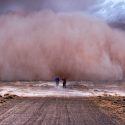You‘re about to make it to the top of this mountain. But as you get ready to take that last step, you can’t feel your toes. They’re completely numb. You take off your boots to see what’s happened and you discover nasty blisters filled with blood. You’re starting to panic. But focus, you only have a few minutes to save yourself from amputation or even death.
Frostbite happens when your skin gets exposed to extremely low temperatures. When the windchill causes the temperature to drop to –26 °C (-18 °F), exposed skin can freeze in less than 30 minutes. This can lead to gangrene or amputation of the area. In the worst case, frostbite can kill you.
Every year, 1,300 Americans die after exposure to cold. What can you do to stay alive? Which body parts are most important to protect? Why is drinking water so important in cold weather? Why is it dangerous to heat up too fast?
Step 1. Keep your shoes on
Make sure to cover up and dress warmly. And pay extra attention to your hands, feet and nose, since those parts are more vulnerable to frostbite.In January 2016, Kristen Hiebert and her four-year-old daughter were in a car accident in -20 °C (-4 °F) weather. With their car stuck in a ditch, they spent more than 10 hours waiting to be rescued until Hiebert gathered the courage to climb the steep embankment to the road and get help.
She lost both shoes in the crash and was barefoot in the snow. She couldn’t feel her feet. But she kept going, knowing that getting to the road was their only chance to survive. Eventually, a car stopped and took Kirsten and her daughter to a hospital. Despite the doctors’ best efforts, Hiebert lost both her lower legs to frostbite.
Step 2. Put the drink down
Dehydration doesn’t only affect you in warmer temperatures. As your body pulls heat to your core to keep you warm, your kidneys work extra hard and expel fluids from your body. You can become dehydrated and more susceptible to frostbite. If you get exposed to freezing cold, you must stay hydrated. Drink water even if you aren’t thirsty. And avoid drinking alcohol since that’ll make your body lose heat faster.
Step 3. Beware of shiny skin
Recognizing the early signs of frostbite might save your life. If you detect and treat it early you can avoid permanent damage. There are three stages of frostbite. First, you’ll feel an itching or a burning sensation in your extremities as your skin’s top layers are affected by the cold. Next, your skin will become hard and look shiny or waxy. Blisters filled with blood will start forming. When frostbite reaches the advanced stage your skin will darken, turn blue and then black.
Step 4. Get warm but not too fast
Once you see the signs of frostbite, it’s essential to get the area warmed up. But do it gradually. Even if getting near a bonfire seems like a great idea, you should avoid any direct heat. Since you’ve lost sensitivity you could risk getting too close to the flames and get a nasty burn. Instead, apply warm water to the affected area. Once it’s warmed, make sure to dry it thoroughly and place a loose, sterile dressing on top.
Step 5. Don’t rub
You’re probably used to rubbing your hands when they’re cold, to increase blood flow and warm them. But with frostbite, you should never rub or massage the skin to warm it. Rubbing can increase the damage to your soft tissues and possibly make things worse.
Well done. You managed to survive getting frostbite. And you can continue mountain climbing. But if you’re planning to scale Mount Everest and don’t want to become the 296th person to die while trying, we can help you here on How to Survive.
Sources
- “Cold Burn: 4 Tips For Avoiding Frostbite – American Outdoor Guide“. American Outdoor Guide.
- “Frostbite: The Cold, Hard Facts | CBC News“. 2022.
- “Frostbite: Causes, Symptoms, Stages, Treatment & Prevention“. 2022. Cleveland Clinic.
- “Woman Minutes From Frostbite In The South Pole As She Wears Shorts And Top In -85F“. 2021. Newsweek.
- “‘He’s An Inspiration’: Alberta Man Who Cheated Death Needs New Prosthetic Leg“. 2021. Calgary.
- “Frostbite – Diagnosis And Treatment – Mayo Clinic“. 2022. Mayoclinic.Org.

















